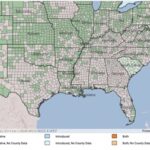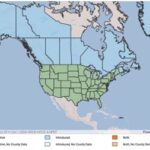Persicaria lapathifolia (Polygonum lapathifolium)
Illustration: USDA-NRCS PLANTS Database / USDA NRCS. Wetland flora: Field office illustrated guide to plant species. USDA Natural Resources Conservation Service.
What is Curly-top Smartweed?
Physical Characteristics
Leaves:
- Sword-shaped
- 2-12 inches long
- 0.39-2 inches wide
Flowers:
- Drooping cluster
- Densely flowered
- Pink or white
- 0.08-0.11 inches long
- 6 stamen
Fruit:
- Round
- Bulging on both sides
- Rough texture
- Dark, shining brown or blackish in color
- 0.08-0.09 inches long
Stem:
- Up to 5 feet tall
- Fleshy
- Swollen above nodes
Where Does it Grow?
USDA, NRCS. 2018. The PLANTS Database (http://plants.usda.gov, 28 March 2018). National Plant Data Team, Greensboro, NC 27401-4901 USA.
Curly-top smartweed can be found in marshes, wet meadows, ponds, lakes and streams.
Pros and Cons of Curly-top Smartweed
Smartweed seeds are heavily consumed by ducks, small birds, and small mammals. Submerged portions of all aquatic plants provide habitats for many micro and macro invertebrates. These invertebrates in turn are used as food by fish and other wildlife species (e.g. amphibians, reptiles, ducks, etc). After aquatic plants die, their decomposition by bacteria and fungi provides food (called “detritus”) for many aquatic invertebrates.


